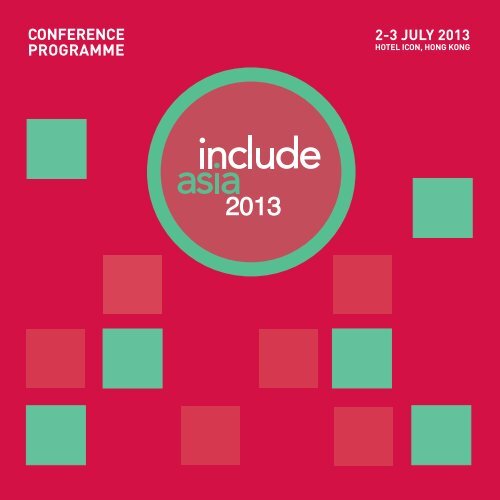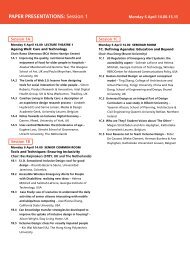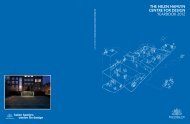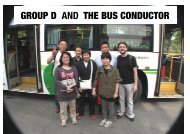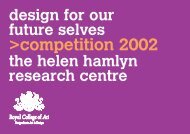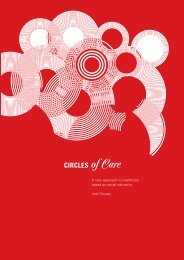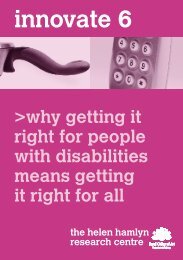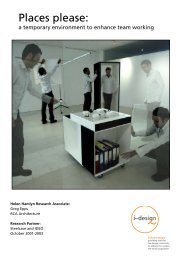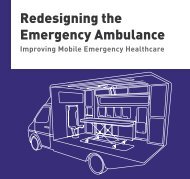conference programme - Helen Hamlyn Centre - Royal College of Art
conference programme - Helen Hamlyn Centre - Royal College of Art
conference programme - Helen Hamlyn Centre - Royal College of Art
- No tags were found...
You also want an ePaper? Increase the reach of your titles
YUMPU automatically turns print PDFs into web optimized ePapers that Google loves.
CONFERENCEPROGRAMME2-3 JULY 2013HOTEL ICON, HONG KONG
ContentsWelcome 1Conference Partners 2Conference Supporters 3Timetable Tuesday 2 July 4Timetable Wednesday 3 July 5Keynote Speaker 6Conference Speakers 7Academic Paper Session Chairs 8Paper Sessions 12Workshops 23Include Conference Series 26Review Committee 27Acknowledgements 28All <strong>conference</strong> papers, workshops and events are correct at time <strong>of</strong> print
WELCOMEJeremy Myerson Cees de Bont Edmund LeeDear DelegateWelcome to the Include Asia <strong>conference</strong> oninclusive design, which takes place for thefirst time in Hong Kong as part <strong>of</strong> Knowledge<strong>of</strong> Design Week. After six successful editionsin London, starting in 2001, the biennialInclude <strong>conference</strong> makes its debut in theAsia Pacific region as a partnership betweenthe <strong>Royal</strong> <strong>College</strong> <strong>of</strong> <strong>Art</strong>, the Hong KongDesign <strong>Centre</strong> and the School <strong>of</strong> Design at TheHong Kong Polytechnic University. We verymuch hope you enjoy what we have in storefor you, in one <strong>of</strong> the most exciting anddynamic cities in the world.Include Asia’s opening <strong>conference</strong> session,academic paper sessions, panel discussions,workshops and awards explore the <strong>conference</strong>theme <strong>of</strong> ‘Global Challenges and LocalSolutions in Inclusive Design’ from a variety<strong>of</strong> angles. This event maps how inclusivedesign thinking and practice can respondto urgent global concerns such as ageingpopulation, climate change and rapidurbanisation with intelligent local solutionsfor individuals and communities. We aregrateful to all the designers and researcherswho have submitted papers to Include Asia2013 and whose knowledge and expertise willbe showcased, and to our <strong>conference</strong> partnersand supporters whohave helped to makeit all happen.Jeremy MyersonDirector, The <strong>Helen</strong> <strong>Hamlyn</strong> <strong>Centre</strong> forDesign, <strong>Royal</strong> <strong>College</strong> <strong>of</strong> <strong>Art</strong>Cees de BontDean, School <strong>of</strong> DesignThe Hong Kong Polytechnic University1Edmund LeeExecutive DirectorHong Kong Design <strong>Centre</strong>
CONFERENCE PARTNERSThe <strong>Helen</strong> <strong>Hamlyn</strong> <strong>Centre</strong> for DesignThe <strong>Helen</strong> <strong>Hamlyn</strong> <strong>Centre</strong> for Design is based atthe <strong>Royal</strong> <strong>College</strong> <strong>of</strong> <strong>Art</strong> in London, one <strong>of</strong> the world’smost influential schools <strong>of</strong> art and design. Thecentre undertakes design research and projects withindustry that will contribute to improving people’slives. Its approach is inclusive and interdisciplinaryand its work is organised in three research labs: Age& Ability, Health & Patient Safety, and Work & City.The centre collaborates with business, academic,government and voluntary sector partners,developing innovative and empathic researchmethods and transferring knowledge via education,events, publications and industrial collaboration.It is endowed by the <strong>Helen</strong> <strong>Hamlyn</strong> Trust, a charitydedicated to supporting innovative projects thatwill effect lasting change. The centre establishedthe Include <strong>conference</strong> series in 2001 and is proudto co-organise the first Include Asia <strong>conference</strong>in Hong Kong.www.hhcd.rca.ac.ukHong Kong Design <strong>Centre</strong>Design for Society is the major undertaking <strong>of</strong> HongKong Design <strong>Centre</strong> (HKDC). HKDC is a non-pr<strong>of</strong>itorganisation and a strategic partner <strong>of</strong> the HongKong Special Administrative Regional Governmentin developing Hong Kong as an international designhub in Asia. Since 2002, HKDC has been on a publicmission to champion strategic and wider use <strong>of</strong>design for creating business value and communitybenefits; promote and celebrate design excellence;and educate the pr<strong>of</strong>essions and the communityto be resourceful champions for sustainabledevelopments through design and innovation.www.hkdesigncentre.orgSchool <strong>of</strong> Design, The Hong Kong PolytechnicUniversityRanked as one <strong>of</strong> the top design schools in theworld by Businessweek and Business Insider, TheHong Kong Polytechnic University School <strong>of</strong> Designis poised to play a leading role in design educationand research in the region. The School providestop-notch <strong>programme</strong>s in advertising, environmentand interior design, product design, communicationdesign, interactive and digital media, at higherdiploma, bachelor, master and PhD levels. Famousdesigners who graduated from PolyU Designinclude Raman Hui (Animation), Freeman Lau(Branding, <strong>Art</strong>), Vivienne Tam (Fashion), AnthonyLo, (Automotive), Yip Kam-tim (Film), Dennis Chan(Jewelry), amongst others.www.sd.polyu.edu.hk2
Charity Trust FundCharity Trust FundMegaman Charity Trust FundSponsor <strong>of</strong> the Include Asia evening receptionThe <strong>conference</strong> partners would like to thank theMegaman Charity Trust Fund for sponsoring theInclude Asia 2013 drinks reception for delegateson Tuesday 2 July 2013.The Megaman Charity Trust Fund is based in HongKong and works internationally. It was establishedin 2008 in recognition <strong>of</strong> the integral role played bythe private sector in meeting the social needs <strong>of</strong>the community.The Megaman Charity Trust Fund supports projectsand <strong>programme</strong>s in two areas: education andenvironmental protection. It is funded by NeonliteElectronic & Lighting (HK) Ltd, the owner <strong>of</strong> theMEGAMAN® trademark.Design ScienceDesign Science is based in Philadelphia, USA andwas founded in 1991. It specialises in conductingresearch and providing design support to optimisethe human interface <strong>of</strong> products. Specific servicesinclude ethnographic field research, human factorssupport and graphic user-interface design, allfor new product development. A particular area<strong>of</strong> focus is inclusive design, especially for homehealthcareproducts.Projects include research for and design <strong>of</strong>interfaces for blood-glucose monitors, insulinpens and other drug-delivery devices, homedialysis systems, and systems for cardiac patients.www.dscience.comMEGAMAN® is a leading designer, manufacturerand marketer <strong>of</strong> innovative lighting solutionsand equipment. It is probably best known for itspioneering work on innovative designs <strong>of</strong> CFLs andLEDs that enable the replacement <strong>of</strong> less efficientlight sources in a wide range <strong>of</strong> applications.www.megamanlighting.com www.megaman.cc3
INCLUDE ASIA 2013 TIMETABLEDay One – Tuesday 2 July8:30 Reception9.00 Opening PlenaryWelcome – Victor Lo, Chairman, Hong Kong Design <strong>Centre</strong>• Paul Chan, Secretary for Development, Government <strong>of</strong> the Hong Kong Special Administrative Region• Chair: Jeremy Myerson, Director, The <strong>Helen</strong> <strong>Hamlyn</strong> <strong>Centre</strong> for Design, RCA, UK• Overview <strong>of</strong> Academic Paper Sessions: Stephen Wilcox, Design Science, USA• Keynote: Kathryn Firth, Chief <strong>of</strong> Design, London Legacy Development Corp, UK10:30 Break10.45 Opening Plenary (continued)• Paul Thompson, Rector, <strong>Royal</strong> <strong>College</strong> <strong>of</strong> <strong>Art</strong>, UK• Keiji Kawahara, Executive Director, International Association for Universal Design (IAUD)• Dan Formosa, Design Consultant and Co-Founder, Smart Design, USAThanks – Cees De Bont, Dean, School <strong>of</strong> Design, The Hong Kong Polytechnic University,12.30 Lunch13.30 Parallel Paper Session 11A Transport & Travel Chair: Sean Donahue, <strong>Art</strong> Center <strong>College</strong> <strong>of</strong> Design, USA (Room 1)1B Digital Interactions Chair: Yasuyuki Hirai Kyushi University, Japan (Room 2)1C Global-Local Chair: Patricia Moore, MooreDesign Associates, USA (Room 3)15.30 Break16.00 Parallel Paper Session 22A Public Space 1 Chair: Satoshi Kose, Shizuoka University <strong>of</strong> <strong>Art</strong> and Culture, Japan (Room 1)2B Diverse Ability Chair: Ed Matthews, The <strong>Helen</strong> <strong>Hamlyn</strong> <strong>Centre</strong> for Design, RCA, UK (Room 2)2C Tools & Techniques Chair: Katherine Gough, Nokia, UK (Room 3)18.00 Break18.30 Include Asia 2013 Drinks Reception, sponsored by Megaman Charity Trust Fund (Hotel ICON Pool Deck)20.00 End <strong>of</strong> Day One4
Day Two – Wednesday 3 July8:30 Reception9.00 Parallel Paper Session 33A Business & Retail Chair: Stephen Wilcox, Design Science, USA (Room 1)3B Digital Interactions Chair: Yasuyuki Hirai, Kyushi University, Japan (Room 2)10:30 Break11.00 Parallel Paper Session 44A Public Space 2 Chair: Alvin Yip, The Hong Kong Polytechnic University, China (Room 1)4B Methods & Models Chair: Yanki Lee, DESIS Lab, Hong Kong Design Institute, China (Room 2)4C Pushing the Boundaries Chair: Jeremy Myerson, The <strong>Helen</strong> <strong>Hamlyn</strong> <strong>Centre</strong> for Design, RCA , UK (Room 3)12.30 Lunch14.00 Include Asia 2013 Conference Plenary and Awards• Include Asia 2013 Awards presentation - Chair: Stephen Wilcox, Design Science, USA• Panel Discussion - Chair: Rama Gheerawo, The <strong>Helen</strong> <strong>Hamlyn</strong> <strong>Centre</strong> for Design, RCA, UK15.30 Break16.00 WorkshopsWorkshop 1: Body & MindStephen Wilcox, Design Science and Dan Formosa, Smart Design, USA (Function Room 1)Workshop 2: Design & CommunityRama Gheerawo and Jeremy Myerson, The <strong>Helen</strong> <strong>Hamlyn</strong> <strong>Centre</strong> for Design, RCA, UK andSean Donahue, <strong>Art</strong> Center <strong>College</strong> <strong>of</strong> Design, USA (Function Room 2)Workshop 3: Inclusive Design in JapanKeiji Kawahara, IAUD and Makoto Oshima,Toyota Boshoku Corporation, Japan (Function Room 3)20.00 End <strong>of</strong> Include Asia 20135
KEYNOTE SPEAKERKathryn FirthChief <strong>of</strong> DesignLondon Legacy Development Corporation, UKAn architect and urban designer with over 25 years <strong>of</strong> experience, KathrynFirth has worked on a range <strong>of</strong> master planning and urban regenerationprojects in the US, Europe, the Middle East and the UK. She has also beeninvolved in research projects that inform both practice and policy such asthe spatial and social dynamics <strong>of</strong> streets and public spaces, and how urbandensity affects neighbourhood perception. She attained her Bachelor <strong>of</strong>Architecture in Toronto and, after practising for a decade, went on to do aMasters <strong>of</strong> Architecture in Urban Design at Harvard’s Graduate School <strong>of</strong>Design. Kathryn has taught at several universities in Canada, the USA andthe UK. She ran the MSc City Design and Social Science at the LSE CitiesProgramme for six years.Her keynote presentation at Include Asia 2013 will explore how the venues,parkland and infrastructure <strong>of</strong> the London 2012 Olympic and ParalympicGames <strong>of</strong>fer a once-in-a-lifetime opportunity to transform a part <strong>of</strong> Londonfor the better. Her talk will illustrate what the ambitious vision for the QueenElizabeth Olympic Park and surrounding areas will physically look like whenit hits the ground. The key social, economic and spatial issues that influencedthe configuration <strong>of</strong> new amenities will be described. The presentation willhighlight inclusive design initiatives that have resulted from engagement,best practice and the desire to retain the positive distinctive qualities <strong>of</strong> eastLondon. It will also touch upon the role <strong>of</strong> design codes, planning and policy.In short, it will outline how the site <strong>of</strong> a big global party – the 2012 Games –is being transformed into local neighbourhoods that are a piece <strong>of</strong> thriving,accessible and integrated city.6
ACADEMIC PAPER SESSION CHAIRSSean Donahue<strong>Art</strong> Center <strong>College</strong> <strong>of</strong> Design, USASean Donahue is principal <strong>of</strong> ResearchCenteredDesign, a Design / Researchpractice and Co-Founder <strong>of</strong> the new Graduate Media Design Practices+FIELDProgramme. Sean’s practice consists <strong>of</strong> pr<strong>of</strong>essional commissions, selfinitiatedresearch, design advocacy, education and publishing. Sean hasaccumulated a portfolio <strong>of</strong> projects that look at how design can makea contribution. His research ranges from media impact studies for citydevelopment to hybrid languages for low and no-vision communities.Sean’s work leads an international dialogue challenging the expectationssurrounding contemporary design practice and social engagement.Rama GheerawoThe <strong>Helen</strong> <strong>Hamlyn</strong> <strong>Centre</strong> for Design, <strong>Royal</strong> <strong>College</strong> <strong>of</strong> <strong>Art</strong>, UKRama Gheerawo is Deputy Director <strong>of</strong> the <strong>Helen</strong> <strong>Hamlyn</strong> <strong>Centre</strong> for Design.He leads the <strong>Centre</strong>’s Age & Ability research lab and is in global demand asa keynote speaker. He writes, curates exhibitions and runs workshops foraudiences ranging from students to business executives, from Californiato China. Knowledge exchange is a key focus, building on over 100 projectswith organisations including BlackBerry®, Samsung and Toyota. He believesthat socially-inclusive design can transform people’s lives.Katherine GoughNokia, UKKatherine Gough is a design researcher and strategist. Trained in IndustrialDesign Engineering at the <strong>Royal</strong> <strong>College</strong> <strong>of</strong> <strong>Art</strong>, she currently leadsethnographic practice at Nokia Design, providing analysis for design,business, R&D and marketing organisations across device and serviceportfolios. Her academic design research with the <strong>Helen</strong> <strong>Hamlyn</strong> <strong>Centre</strong>for Design developed user-centred tools for Unilever, Marks & Spencerand Nestlé.8
Yasuyuki HiraiKyushu University, JapanYasuyuki Hirai is associate pr<strong>of</strong>essor teaching social innovation approachesat the Faculty <strong>of</strong> Design <strong>of</strong> the Kyushu University in Fukuoka, Japan. Since2000. He has more than 20 years <strong>of</strong> experience as a design consultant,working for a large <strong>of</strong>fice furniture manufacturer in Japan and IDEO in theUSA. The focus <strong>of</strong> Yasuyuki’s work includes developing communication tools,for example a medicine diary design for children, in collaborationwith chemists and parents.Satoshi KoseShizuoka University <strong>of</strong> <strong>Art</strong> and Culture, JapanSatoshi Kose specialises in the field <strong>of</strong> building use and safety, human factorsand universal design. He has published many papers on designing for theageing society and universal design, including a chapter in The UniversalDesign Handbook from McGraw Hill. Satoshi was among the first awardees<strong>of</strong> the Ron Mace Design for the 21st Century Award in June 2000. His work todevelop housing design guidelines for the ageing society in Japan has nowbecome the de-facto standard for new homes.Yanki LeeDESIS Lab, Hong Kong Design Institute, ChinaDr Yanki Lee is co-founder <strong>of</strong> EXHIBIT at Golden Lane Estate, a London-basedsocial design agency. She graduated with an MA in Architecture from the<strong>Royal</strong> <strong>College</strong> <strong>of</strong> <strong>Art</strong> and a PhD in Design Participation from The Hong KongPolytechnic University. Yanki was a Research Fellow at The <strong>Helen</strong> <strong>Hamlyn</strong><strong>Centre</strong> for Design where she worked as co-investigator on the i~design 3project, developing an online platform (www.designingwithpeople.org) toencourage people-centred design practice. She was awarded the BISUK-China Fellowship <strong>of</strong> Excellence in 2011.9
ACADEMIC PAPER SESSION CHAIRS (Continued)Ed MatthewsThe <strong>Helen</strong> <strong>Hamlyn</strong> <strong>Centre</strong> for Design, <strong>Royal</strong> <strong>College</strong> <strong>of</strong> <strong>Art</strong>, UKEd Matthews joined the <strong>Helen</strong> <strong>Hamlyn</strong> <strong>Centre</strong> for Design in 2007 as SeniorResearch Fellow to lead the centre’s work in design for healthcare and patientsafety. Previously he consulted in product design and development over arange <strong>of</strong> industries prior to focusing on the design and engineering <strong>of</strong> medicaldevices including running a successful design firm. He secures, manages andsupervises healthcare projects with UK Research Councils and the centre’sindustry partners, collaborating with academic institutions, the NHS andmanufacturers.Scott MaysonRMIT University, AustraliaDr Scott Mayson is an academic at RMIT university, Melbourne, in IndustrialDesign. He was awarded a PhD in 2006 where he designed a novel approachto Orthopaedic ligament reconstruction within the knee joint. His researchinterests are in inclusive, service and medical design. He is an industrialdesign academic at RMIT University with interests in additive manufacturingimage making, design thinking, disruption, processes and practice baseddesign methods.Patricia MooreMooreDesign Associates, USADr Patricia Moore is a renowned gerontologist and designer, serving as aninternational authority on lifespan needs. For three years Patricia travelledaround the USA and Canada disguised as a women <strong>of</strong> over 80. Her EmpathicElder Research resulted in ID Magazine naming her one <strong>of</strong> The World’s 40Most Socially Conscious Designers and she was selected by a consortium <strong>of</strong>news editors and organisations as one <strong>of</strong> The 100 Most Important Women inAmerica. ABC World News featured Patricia as one <strong>of</strong> 50 Americans Definingthe New Millennium.10
Jeremy MyersonThe <strong>Helen</strong> <strong>Hamlyn</strong> <strong>Centre</strong> for Design, <strong>Royal</strong> <strong>College</strong> <strong>of</strong> <strong>Art</strong>, UKJeremy Myerson is Director <strong>of</strong> the <strong>Helen</strong> <strong>Hamlyn</strong> <strong>Centre</strong> for Design at the<strong>Royal</strong> <strong>College</strong> <strong>of</strong> <strong>Art</strong> and the first-ever holder <strong>of</strong> the <strong>Helen</strong> <strong>Hamlyn</strong> Chair<strong>of</strong> Design with a remit to encourage ‘design that improves quality <strong>of</strong> life’.An academic, author and activist in design for over 30 years, he co-foundedthe <strong>Helen</strong> <strong>Hamlyn</strong> <strong>Centre</strong> for Design in 1999 and his interdisciplinary researchspans healthcare, workplace and inclusive design. He sits on the advisoryboard <strong>of</strong> the Jockey Club Design Institute for Social Innovation in Hong Kong.Stephen WilcoxPrincipal, Design Science, USADr Stephen Wilcox holds a BSc in Psychology and Anthropology from TulaneUniversity, a PhD in Experimental Psychology and a Certificate in BusinessAdministration. He is the Founder and a Principal <strong>of</strong> Design Science, aPhiladelphia-based firm that specialises in helping companies make theirproducts as user-friendly as possible. Stephen has published more than 60articles and given many invited addresses to various organisations. He is theauthor, with Michael Wiklund, <strong>of</strong> Designing Usability into Medical Products(Taylor & Francis/CRC Press, 2005).Alvin YipJockey Club, Design Institute for Social Innovation, The Hong KongPolytechnic University, ChinaAlvin Yip’s research spans design with social relevance, social value, socialimpact, and societal change on public space. He curates exhibitions thatinclude Rice Fields (Moscow, 2011) and Fashion Guerilla (Paris,2013). Alvinwas a winner <strong>of</strong> Hong Kong Institute <strong>of</strong> Architects Award, Rome Scholar,Ten Outstanding Young Persons, and received a commendation forarchitecture on the HKSAR 2010 Honours List. He also serves as boardmember <strong>of</strong> the Federation <strong>of</strong> Design Associations, Ambassadors <strong>of</strong> Design,and Architecture <strong>Centre</strong>.11
PAPER SESSIONS“We are very pleased with the papers presented at Include Asia 2013. As the <strong>programme</strong> illustrates,we have papers on a wide variety <strong>of</strong> topics addressing our <strong>conference</strong> theme <strong>of</strong> ‘Global Challenges andLocal Solutions’. The papers discuss a wide variety <strong>of</strong> inclusive design challenges (e.g. improving mobility,making digital tools more inclusive and optimising public spaces). They discuss new tools for addressingthese and other design problems, and provide general perspectives on inclusivity – such as cultural issuesand changes with age. We are inspired by the truly global nature <strong>of</strong> our presenters and <strong>of</strong> thetopics addressed, including a number <strong>of</strong> papers from colleagues in the region.”Stephen Wilcox, Chair, and Rama Gheerawo, Deputy Chair, Include Asia 2013 Review CommitteeSESSION 1A Tuesday 2 July 13.30-15.30, Room 1Transport & TravelChair: Sean Donahue (<strong>Art</strong> Center <strong>College</strong> <strong>of</strong> Design, USA)Remaining mobile is a key to maintaining personal independence and is important in accessing services,social networks and neighbourhoods. Papers present transport challenges and solutions from aroundthe globe, with projects from UK, Japan, India, Singapore and Brazil.1A.1 Better Healthcare Delivery – ambulances that don’t (always) transport patients (invited paper)Ed Matthews and Gianpaolo Fusari, The <strong>Helen</strong> <strong>Hamlyn</strong> <strong>Centre</strong> for Design, RCA, UK1A.2 Approaches to Developing Creative Future Mobility Solutions by Applying Inclusive DesignStrategiesBen Meyer and Brigid O’Kane, University <strong>of</strong> Cincinnati, USA1A.3 Wayfinding for Visually Impaired PedestriansDr Theresa Beco de Lobo, UNIDCOM/IADE-U-Creative University, Portugal1A.4 An Inclusive Wayfinding Assessment Tool in the Context <strong>of</strong> Singapore’s Public Transport SystemShereen Sze-Wan Pong, <strong>Centre</strong> for Ageing Studies, Temasek Polytechnic, Singapore1A.5 Shopping Fresh Food in the Future: are transportation choices available to future seniors?Satoshi Kose, Shizuoka University <strong>of</strong> <strong>Art</strong> and Culture (SUAC), Hamamatsu, Japan12
SESSION 1B Tuesday 2 July 13.30-15.30, Room 2Digital InteractionsChair: Yasuyuki Hirai (Kyushu University, Japan)Digital technologies are ever-present in daily life and there is increasing reliance on the services andsupport that they provide. This session looks at a socially inclusive approach to technology from desktopmanufacturing to managing chronic conditions through ‘crowd sourcing’.1B.1 People-<strong>Centre</strong>d Desktop Design and Manufacture: a review <strong>of</strong> web enabled open source toolsfor localised community focused inclusive designDr Scott Mayson, RMIT University, Australia1B.2 Where do you go to…? Designing ‘connectedness’ in digital public spaceClaire McAndrew 1 , Ben Dalton 2 and Bridget Hardy 31 The Bartlett School <strong>of</strong> Graduate Studies, University <strong>College</strong> London, UK2 <strong>Royal</strong> <strong>College</strong> <strong>of</strong> <strong>Art</strong>, UK3 Integrans Consulting, UK1B.3 GIS-Participation: an inclusive design approachPr<strong>of</strong>essor Graeme Evans, Middlesex University (<strong>Art</strong> & Design) and Steve Cinderby, YorkUniversity (Stockholm Environment Institute), UK1B.4 Can a Crowd Sourcing App, for those with Chronic Conditions, lead to Innovation DesignSolutions?Lisa Austin and Pr<strong>of</strong>essor Christopher Eccleston, <strong>Centre</strong> for Pain Research, University<strong>of</strong> Bath, UK1A.5 Towards an Empowering Tangible Interaction Design for AllBirgitta Cappelen, The Oslo School <strong>of</strong> Architecture and Design, Norway13
SESSION 1C Tuesday 2 July 13.30-15.30, Room 3Global-LocalChair: Patricia Moore, MooreDesign Associates, USAThough inclusive design has a globally relevant philosophy, local variation needs to be acknowledgedwhen putting the approach into practice. This session looks at inclusive design in different culturalcontexts including Finland, Israel, Afghanistan, China and India.1C.1 Shifting Perspectives: design for ASHA health workers in rural IndiaArnab Chakravarty 1 and Samiksha Kothari 21 Srishti Labs – Srishti School <strong>of</strong> <strong>Art</strong>, Design and Technology, India2 Industrial Design <strong>Centre</strong>, IIT Bombay, India1C.2 Challenging the Standard: designing schools for women in AfghanistanElizabeth Golden Department <strong>of</strong> Architecture, University <strong>of</strong> Washington, USA1C.3 Framing the Temporal Territory <strong>of</strong> Inclusivity: cultural reflections on Finnish design heritageFahrettin Ersin Alaca, Aalto University, School <strong>of</strong> <strong>Art</strong>s, Design and Architecture, Finland1C.4 Mapping the Common Ground: inclusive playscapes for children in Jerusalem – from globalto localTali Cohen Anderson, Department <strong>of</strong> Interior Design, The <strong>College</strong> <strong>of</strong> Management – AcademicStudies, Israel1C.5 Understanding User Experience in Persuasive Systems as a Way <strong>of</strong> Informing the Design<strong>of</strong> Inclusive Health Systems: an example <strong>of</strong> online diabetes self-management systems forChinese older adultsBarbara Wong, The Hong Kong Polytechnic University, China14
SESSION 2A Tuesday 2 July 16.00-18.00, Room 1Public Space 1Chair: Satoshi Kose, Shizuoka University <strong>of</strong> <strong>Art</strong> and Culture, JapanUrban spaces and public buildings need to cater to a wide variety <strong>of</strong> people with different needs. Thesepapers present applied projects looking at wayfinding for visually impaired people, park furniture, publicsquares and airports. They are drawn from Europe, Brazil and Hong Kong.2A.1 Park Seating Furniture Design in Hong Kong: a case study <strong>of</strong> inclusive design and its relationto user interactionYH Brian Lee, LH Denise Chan and MX Tang, School <strong>of</strong> Design, The Hong Kong PolytechnicUniversity, China2A.2 Inclusive Design for a Barrier Free City – case study <strong>of</strong> the city <strong>of</strong> Lincoln, UKSophia Bannert and Dr Amira Elnokaly, Lincoln School <strong>of</strong> Architecture, University <strong>of</strong> Lincoln, UK2A.3 Wayfinding Evaluation in Hercílio Luz Airport in Florianópolis, Santa Catarina, BrazilVera <strong>Helen</strong>a Moro Bins, Isabela Fernandes Andrade (also at Federal University <strong>of</strong> Pelotas),Julia Moraes Callado de Amorim, Carolina Oliveira da Silva and Rodrigo Acosta de Souza,Federal University <strong>of</strong> Santa Catarina, Brazil2A.4 Accessibility and Appropriation: analysing squares’ quality in Florianópolis, BrazilLarissa Miranda Heinisch 1 , Gabriela Yoshitani da Luz 1 , Vanessa Goulart Dorneles 1,Vera <strong>Helen</strong>a Moro Bins Ely 1 and Fábio Lúcio Lopes Zampieri 21 Universidade Federal de Santa Catarina, UFSC, Brazil2 Universidade Federal da Fronteira Sul, UFFS, Brazil2A.5 Wayfinding Systems for Users with Visual DisabilitiesDr Theresa Beco de Lobo, UNIDCOM/IADE-U-Creative University, Portugal15
SESSION 2B Tuesday 2 July 16.00-18.00, Room 2Diverse AbilityChair: Ed Matthews (The <strong>Helen</strong> <strong>Hamlyn</strong> <strong>Centre</strong> for Design, <strong>Royal</strong> <strong>College</strong> <strong>of</strong> <strong>Art</strong>, UK)This session focuses on design for people with different abilities. Topics include the treatment <strong>of</strong>disabled people in the workplace, assessments <strong>of</strong> approaches to inclusive design in India, USA andJapan, and the use <strong>of</strong> haptics and audio to support communication.2B.1 Challenging Employment Attitudes: understanding the role <strong>of</strong> inclusive design for the inclusion<strong>of</strong> disabled peopleJimena Gomez, University <strong>of</strong> Cambridge, UK2B.2 Vocal and Tangible Interaction Crossing BordersBirgitta Cappelen, The Oslo School <strong>of</strong> Architecture and Design, Norway2B.3 Designing Innovative Assistive Technologies in Multidisciplinary Teams and OvercomingPerceptual Gaps to Maximize CreativityStephen Sundarrao, Don Dekker, Kevin White and Rajiv Dubey, University <strong>of</strong> South Florida, USA2B.4 Helping Visually Impaired Visitors ‘See’ Exhibits in Hong Kong MuseumsMeng Kheong Chan, The Hong Kong Polytechnic University, Hong Kong2B.5 Design Management for Vocational Aid <strong>Centre</strong>sYasuko Takayama, and Satoshi Kose, Shizuoka University <strong>of</strong> <strong>Art</strong> and Culture, Japan16
SESSION 2C Tuesday 2 July 16.00-18.00, Room 3Tools & TechniquesChair: Katherine Gough (Nokia, UK)These papers collectively discuss established and emerging tools and techniques for applying inclusivedesign. Areas covered include designing to support people with dementia, co-design in public services,the fashion retail experience, museum design and lighting urban communities.2C.1 Museum For All Project in Japan – co-creating ‘my kind <strong>of</strong> museum’Yasuyuki Hirai, Yoshiyasu Ota, Tomomi Okazaki, Kozue Handa, Ayumi Umeda, Noboru Matsuura,Laila Cassim and Tomoko Takei, Kyushu University, Japan2C.2 Towards Designing a Long-Term Assistive Environment for People with DementiaAndreas Pusch 1 , Anja B. Naumann 2 , Michael Brandt 3 and Jörn Hurtienne 11 Psychological Ergonomics, Julius-Maximilians-Universität, Germany2 Institute <strong>of</strong> Transportation Systems, German Aerospace Center (DLR), Germany3 Human-Computer Systems, Julius-Maximilians-Universität, Germany2C.3 Enhancing Social Interactions through Inclusive Fashion Retail ExperienceDr Busayawan Lam, Brunel University, UK2C.4 Service Co-design with the Public Sector – challenges and opportunities in a healthcare contextKirsikka Vaajakallio, Jung-Joo Lee and Juha Kronqvist, Tuuli Mattelmäki, Aalto UniversitySchool <strong>of</strong> <strong>Art</strong>s, Design and Architecture, Finland2C5In The Shade: lighting local urban communities (invited paper)Jeremy Myerson, Megan Charnley and Tom Jarvis, the <strong>Helen</strong> <strong>Hamlyn</strong> <strong>Centre</strong> for Design, <strong>Royal</strong><strong>College</strong> <strong>of</strong> <strong>Art</strong>, UK17
SESSION 3A Wednesday 3 July 09.00-10.00, Room 1Business & RetailChair: Stephen Wilcox (Design Science, USA)Embedding an inclusive design approach into business processes and retail strategies is an increasinglyimportant factor in organisational success. These papers discuss how user engagement can helpchange perspectives and inform business decisions.3A.1 Inclusive Apparel Products and Retail Environments for Elderly Consumers: A ChinesePerspectiveHong Yu and Shilei Pan, Ryerson University, Canada3A.2 Observing Everyday Usage – bringing observations from everyday lives to design and businessdecisionsKatherine Gough 1 , Michael Davis-Burchat 1 , Dr Bas Raijmakers 2 and Dr Geke van Dijk 21 Nokia, UK2 STBY, The Netherlands3A.3 Challenges Faced by Clients and Designers: strategic phases for inclusive design adoptionEmilene Zitkus, Patrick Langdon, John P Clarkson, University <strong>of</strong> Cambridge, UK18
SESSION 3B Wednesday 3 July 09.00-10.00, Room 2Perspectives on AgeingChair: Scott Mayson (RMIT University, Australia)Ageing is a central concern <strong>of</strong> inclusive design. This session spans a variety <strong>of</strong> approaches, from cocreationwith older people in rural China to a study into the meaning <strong>of</strong> ‘homeliness’ in care homes.A design project from the USA working with older people in Ugandan communities is also presented.3B.1 A Systematic Review <strong>of</strong> the Literature Concerning Design Considerations <strong>of</strong> Homeliness inCare HomesAnne Fleming 1 ;Dr Pauline Banks 1 , Dr Angela Kydd 1 and Sally Stewart 21 University <strong>of</strong> West <strong>of</strong> Scotland2 Glasgow School <strong>of</strong> <strong>Art</strong>, UK3B.2 ‘I didn’t know I can teach!’ – empowering Chinese retirees through co-creating amultigenerational ceramic serviceYuan Wu Tang 1 , Jung-Joo Le 2 ,1 Tang consulting, China2 Aalto University School <strong>of</strong> <strong>Art</strong>s, Design and Architecture, Finland3B.3 Ageing in Place in Central Africa: moving away from an international rights definitiontowards community-led models (invited paper)Sean Donahue, <strong>Art</strong> Center <strong>College</strong> <strong>of</strong> Design, USA19
SESSION 4A Wednesday 3 July 11.30-13.00, Room 1Public Space 2Chair: Alvin Yip (The Hong Kong Polytechnic University)These papers examine frameworks and models for applying inclusive design within public space,looking at the interaction <strong>of</strong> people with the environment and the importance <strong>of</strong> involving citizens andneighbourhoods in a co-design process. Work is drawn from Hong Kong, Finland and Venezuela.4A.1 Behaviorological Analysis <strong>of</strong> Global Local Solutions in Production <strong>of</strong> Space: Hong Kong andGuangzhouEva Cheung, University <strong>of</strong> Auckland, New Zealand4A.2 Micro Scale Neighbourhood Revitalization through Design InterventionsSandra Viña, Aalto University, Finland4A.3 The Cracks Through Which We Fall: challenging the independence <strong>of</strong> design disciplines for thebuilt environmentDr David Osborne, Graphia Brands, Hong Kong, China20
SESSION 4B Wednesday 3 July 11.30-13.00, Room 2Methods & ModelsChair: Yanki Lee (DESIS Lab, Hong Kong Design Institute)This session discusses emerging frameworks and approaches for inclusive design. Topics coveredinclude developing theory from practice, rationalising the different terminology that exists aroundpeople-centred design, and evolving participatory approaches.4B.1 Design(ing) for More: towards a global design approach and local methodsJasmien Herssens, Hasselt University, Hasselt, Belgium4B.2 Evolution <strong>of</strong> the Public and the Private Sector for Enforcing Barrier-Free Environmentin TaiwanTzeng Szu-Yu, National Yunlin University <strong>of</strong> Science and Technology, Taiwan4B.3 Designing Living Environment with Younger Citizens using Participatory Action ResearchMethods: process and evaluationsDr Yan Chi, Jackie Kwok and Kaman Ka Man TSANG, School <strong>of</strong> Design, The Hong KongPolytechnic University, China21
SESSION 4C Wednesday 3 July 11.30-13.00, Room 3Pushing the BoundariesChair: Jeremy Myerson (<strong>Helen</strong> <strong>Hamlyn</strong> <strong>Centre</strong> for Design, <strong>Royal</strong> <strong>College</strong> <strong>of</strong> <strong>Art</strong>, UK)Papers look at how inclusive design is being applied in creative new ways to address issues includingdisaster management and relief, socially ignored groups such as sex trade workers and opportunitiesaround digital technologies to support enterprise in rural India.4C.1 Design+Disaster: the inclusive challengePatricia Moore, MooreDesign Associates, USA4C.2 Out <strong>of</strong> the ShadowsPr<strong>of</strong>essor Susan Barnwell, Ryerson University, School <strong>of</strong> Fashion, Toronto, Canada4C.3 Marketing Rural Enterprises in India – intermediated use <strong>of</strong> technology as a design strategyArnab Chakravarty 1 and Samiksha Kothari 21 Srishti School <strong>of</strong> <strong>Art</strong>, Design and Technology, India2 Industrial Design <strong>Centre</strong>, IIT Bombay, India22
WORKSHOP 1 Wednesday 3 July 16.00 -20.00, Function Room 1Body & MindStephen Wilcox, Design Science, USADan Formosa, Smart Design, USAThis workshop will be interactive, allowing participants to meet and workwith each other and explore the topics presented. Stephen Wilcox and DanFormosa will be discussing how people work, using both body and mind.Creating products that work for everyone and understanding the mechanics<strong>of</strong> the human body is essential and cannot be separated from how the mindworks – understanding what people perceive, learn and remember.BodyBiomechanics describes the mechanical engineering <strong>of</strong> the body lookingat how our muscles, bones, tendons and ligaments work – and don’t work.Topics covered will include:1. How your hand, arm and shoulder works2. Levers, gravity and balance – how to optimise human power3. Gender and ethnic variations to be considered, and their impact4. Opportunities to innovate by understanding the body.MindThe purpose <strong>of</strong> the ‘mind’ part <strong>of</strong> the workshop will be to provide anoverview <strong>of</strong> information from psychology that is useful for making designdecisions. Topics covered will include:1. Why the traditional concept <strong>of</strong> the mind is a barrier to doing anythinguseful.2. What we know about human perception and how it applies to design.Designing for ease <strong>of</strong> learning and ease remembering.3. How sympathetic arousal affects how people see and how they behave4. Understanding error and its elimination.23
WORKSHOP 2 Wednesday 3 July 16.00 - 20.00, Function Room 2Design & CommunityRama Gheerawo, The <strong>Helen</strong> <strong>Hamlyn</strong> <strong>Centre</strong> for Design, <strong>Royal</strong> <strong>College</strong> <strong>of</strong> <strong>Art</strong>, UKSean Donahue, <strong>Art</strong> Center <strong>College</strong> <strong>of</strong> Design, USAJeremy Myerson, The <strong>Helen</strong> <strong>Hamlyn</strong> <strong>Centre</strong> for Design, <strong>Royal</strong> <strong>College</strong> <strong>of</strong> <strong>Art</strong>, UKPeople-centred design has a history <strong>of</strong> talking to individual users butdesigners increasingly will have to work with groups and communitiesin order to make larger scale and sustainable change.This workshop addresses this developing practice. Aimed at designers,researchers, educators and business people alike, the session will involvetraditional inclusive design techniques, giving you practical exercises andtechniques you can apply immediately in communities.Case studies will reinforce the value <strong>of</strong> this approach as ‘crowd-sourcing’,social innovation and community-led innovation becomes ever moreimportant for designers today. Participants will be shown some novelapproaches and go through practical exercises to reinforce the theorythrough practice.24
WORKSHOP 3 Wednesday 3 July 16.00 -20.00, Function Room 3Inclusive Design in JapanKeiji Kawahara, IAUD, JapanMakoto Ooshima, Toyota Boshoku Corporation, JapanWhy are Japanese products so cool? How can Japanese designerscare about people? These questions <strong>of</strong>ten arise in the western world.It is not seen as special for the Japanese to focus on their customersor stakeholders because they simply believe it is their duty. Nevertheless,there might be some hidden secrets to their thinking processes.In this workshop, a managing <strong>of</strong>ficer <strong>of</strong> Toyota Boshoku Corporation,Makoto Ooshima, will introduce the essence <strong>of</strong> Japanese design andmethodologies with some inspirational case studies which will encourageworkshop participants to start thinking about inclusive design fromdifferent perspectives.25
THE INCLUDE CONFERENCE SERIESThese images capture the flavour <strong>of</strong> the Include <strong>conference</strong>s (2001-2011) at the <strong>Royal</strong> <strong>College</strong> <strong>of</strong> <strong>Art</strong>, London26
INCLUDE REVIEW COMMITTEEMembers <strong>of</strong> the Include Review Committee are responsible for reviewing andselecting the papers at the <strong>conference</strong>Dr Stephen Wilcox, Design Science, USA (Chair)Rama Gheerawo, The <strong>Helen</strong> <strong>Hamlyn</strong> <strong>Centre</strong> forDesign, RCA, UK (Deputy Chair)Francesc Aragall, Design for All Foundation, SpainKarin Bendixen, Bexcom, DenmarkTom Bieling, Universität der Künste Berlin, GermanyStephen Boyd-Davis, Research Dept, RCA, UKDr Giuseppe Di Bucchianico, University <strong>of</strong> ChietiPescara, ItalyJulia Cassim, The <strong>Helen</strong> <strong>Hamlyn</strong> <strong>Centre</strong> for Design,RCA, UKPr<strong>of</strong> Chetwyn Chan, The Hong Kong PolytechnicUniversity, ChinaPr<strong>of</strong> Sooshin Choi, University <strong>of</strong> Cincinnati, USAPr<strong>of</strong> Alison Clarke, University <strong>of</strong> Vienna, AustriaSharon Cook, Loughborough University, UKBen Dalton, Creative Exchange Hub, RCA, UKDr Kathrina Dankl, University <strong>of</strong> Vienna, AustriaPr<strong>of</strong> Cees Debont, The Hong Kong PolytechnicUniversity, ChinaOnny Eikhaug, Norwegian Design Council, NorwayDr Eddy Elton, University <strong>of</strong> Brighton, UKJohn Fass, Creative Exchange Hub, RCA, UKDr Antoinette Fennell, National Council for the Blind<strong>of</strong> Ireland, IrelandValerie Fletcher, Institute <strong>of</strong> Human CenteredDesign, USADr Dan Formosa, Smart Design, USAKatherine Gough, Nokia, UKIlona Gurjanova, Estonian Association <strong>of</strong> Designers,Pr<strong>of</strong> Gordon Kennedy, Nottingham Trent University, UKPeter Kercher, EIDD - Design for All Europe, ItalyPr<strong>of</strong> Satoshi Kose, Shizuoka University <strong>of</strong> <strong>Art</strong> andCulture, JapanMerih Kunur, The <strong>Helen</strong> <strong>Hamlyn</strong> <strong>Centre</strong> for Design,RCA, UKDr Pat Langdon, University <strong>of</strong> Cambridge, UKIrene Leung, Senior Citizen Home SafetyAssociation, Hong Kong, ChinaDr Andre Liem, Norwegian University <strong>of</strong> Science andTechnology, NorwayEd Matthews, The <strong>Helen</strong> <strong>Hamlyn</strong> <strong>Centre</strong> for Design,RCA, UKDr Scott Mayson, RMIT University, AustraliaPr<strong>of</strong> Johan Molenbroek, TU Delft, The NetherlandsChris McGinley, The <strong>Helen</strong> <strong>Hamlyn</strong> <strong>Centre</strong> forDesign, RCA, UKPr<strong>of</strong> Jeremy Myerson, The <strong>Helen</strong> <strong>Hamlyn</strong> <strong>Centre</strong> forDesign, RCA, UKDr Peter Neumann, Neumann Consult, UKFarnaz Nickpour, Brunel University, UKColette Nicolle, Loughborough University, UKDr Wang-chin Tsai, Fo Guang University, TaiwanJonathan West, The <strong>Helen</strong> <strong>Hamlyn</strong> <strong>Centre</strong> forDesign, RCA, UKKatherine Wilkinson, RMIT University, AustraliaAlvin Yip, Jockey Club, Design Institute for SocialInnovation; The Hong Kong Polytechnic University,China27
ACKNOWLEDGEMENTSInclude Asia 2013 is a partnership between the <strong>Royal</strong> <strong>College</strong> <strong>of</strong> <strong>Art</strong>, UK;the Hong Kong Design <strong>Centre</strong> and the School <strong>of</strong> Design at The Hong KongPolytechnic University.The <strong>Helen</strong> <strong>Hamlyn</strong> <strong>Centre</strong> for Design:Conference Director: Belinda AbbottProgramme co-ordination:Rama Gheerawo, Chris McGinley, Jeremy Myerson,and Jonathan WestPublications and Graphics: Margaret DurkanBusiness Management: Kay SandfordHong Kong Design <strong>Centre</strong>:Chairman: Dr Victor LoExecutive Director: Dr Edmund LeeExecution: The KODW staff teamThe Hong Kong Polytechnic University School<strong>of</strong> Design:Dean & Swire Chair Pr<strong>of</strong>essor <strong>of</strong> Design:Pr<strong>of</strong> Cees de BontDirector, Jockey Club Design Institute for SocialInnovation: Alvin YipConference co-ordination: Margaret Ho, Mandy SoPhotographer: Johnny KwokTechnical support: CW Woo and student helpersInclude Asia 2013 Drinks ReceptionKindly sponsored by Megaman Charity Trust Fund,with thanks to Fred Bass and Sharon Pang.Conference System Management: Kinetix Eventswith many thanks to Sally Hawkes for her helpand supportwww.kinetixevents.co.ukThanks also to:Hotel ICONTurkish AirlinesSun Tao Printing Co Ltd28


